|
|
|
Sort Order |
|
|
|
Items / Page
|
|
|
|
|
|
|
| Srl | Item |
| 1 |
ID:
134899
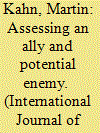

|
|
|
|
|
| Summary/Abstract |
When the Soviet Union and the United States became potential enemies at the end of World War II increased U.S. resources were spent on trying to better understand the USSR's economy and society. As the Cold War escalated in the immediate post-war years new U.S. organizations were created to analyze the USSR. Studies have been conducted about U.S. government assessments of the USSR during the Cold War, for example regarding the Central Intelligence Agency's (CIA) estimates of Soviet capabilities and intentions. 1 But the United States had already been trying to assess Soviet capabilities before the onset of the Cold War, and these efforts were of particular interest during World War II, when Soviet resources were being used against a common enemy: the Axis Powers.
|
|
|
|
|
|
|
|
|
|
|
|
|
|
|
|
| 2 |
ID:
134901
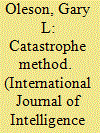

|
|
|
|
|
| Summary/Abstract |
The budget reductions being imposed on both the military and intelligence communities will result in greater risk from emerging or concealed threats as information about such threats declines along with Washington's abilities to respond to them. The decline in intelligence expenditures, in particular, increases the likelihood that serious threats will evade detection and identification. A potential adversary could suddenly present the United States with a long-duration threat to its electrical grid or a crippling blow to its overseas force projection. Failure to look for such concealed threats is a formula for unacceptable strategic surprise. Since the natural tendency of intelligence operations is to focus available resources on known threats, looking for concealed threats is as much a challenge to resource allocation as search methodology. Both challenges can arguably be addressed by focusing on the most intolerable of potential consequences: national catastrophes.
|
|
|
|
|
|
|
|
|
|
|
|
|
|
|
|
| 3 |
ID:
134900


|
|
|
|
|
| Summary/Abstract |
Described herein is an easily done exercise that demonstrates the benefits of aggregated analysis. It might be employed by instructors of intelligence analysis as an exercise in the classroom, or by the intelligence practitioners seeking some “hands on” experience with something they have heard of, but have not personally worked with.
Aggregated analysis refers to the taking of a large number of independent assessments and mathematically aggregating them to form a single assessment. This process does not include brainstorming, for example, where individuals actively interact with each other while forming the group assessment.
|
|
|
|
|
|
|
|
|
|
|
|
|
|
|
|
| 4 |
ID:
134926
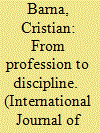

|
|
|
|
|
| Summary/Abstract |
One factor that has led to profound changes in the evolution of intelligence is the removal of many physical and ideological barriers that previously prevented communication and interaction, as existed in the Cold War era. In this ideological post-war period, in which most societies are no longer militarily threatened but rather politically, economically, culturally, and perhaps religiously, undermined, intelligence services are facing new challenges, being called upon to contribute to the reduction or removal of a series of threats and negative effects.
|
|
|
|
|
|
|
|
|
|
|
|
|
|
|
|
| 5 |
ID:
134898
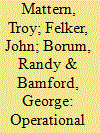

|
|
|
|
|
| Summary/Abstract |
Managing these economic and national security hazards in cyberspace has been a vexing problem. 6 Most discourse about cybersecurity solutions has focused on defensive measures, mainly ways to protect the perimeter around sensitive data, information, and systems. Network and system administrators worry about reacting to network intrusions and compromises so that system downtime is minimized and usage can be continued with minimal interruption. While improving network security and information assurance technology may be necessary, these measures are not sufficient to counter the complex and evolving array of cyber threats. Because current reactive approaches are not working, fundamentally changing how to understand and operate in cyberspace is necessary. 7 A transformed approach to cybersecurity cannot rely solely on responding to known threats; it must also track the capabilities, intentions, and activities of potential adversaries and competitors, as they evolve, in the cyber realm. 8 That set of information and associated functions is referred to as Cyber Intelligence.
|
|
|
|
|
|
|
|
|
|
|
|
|
|
|
|
| 6 |
ID:
134928


|
|
|
|
|
| Summary/Abstract |
Oversee and facilitate the collection, evaluation, classification, and dissemination of foreign intelligence collected from clandestine sources. CMOs play a critical role in ensuring that foreign intelligence collected by clandestine sources is relevant, timely, and addresses the highest foreign policy and national security needs of the nation. CMOs are substantive experts in their area of specialty, have a comprehensive knowledge of how National Clandestine Service operations are conducted, and an in depth understanding of overseas operating environments as well as current and looming international issues.
|
|
|
|
|
|
|
|
|
|
|
|
|
|
|
|
| 7 |
ID:
134927
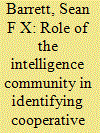

|
|
|
|
|
| Summary/Abstract |
While a lot has been written about the Department of Defense's (DoD) ongoing Strategic Choices and Management Review and the 2014 Quadrennial Defense Review, 1 far less attention has been paid to the role of intelligence and the Intelligence Community (IC) in both processes and, more broadly, in informing both defense and grand strategy.
|
|
|
|
|
|
|
|
|
|
|
|
|
|
|
|
| 8 |
ID:
134896


|
|
|
|
|
| Summary/Abstract |
At the beginning of the Gorbachev era the KGB's penetration of state and society in the Soviet Union was profoundly and extensively due to the history of the Soviet Communist dictatorship. From the beginning, the search for internal and external opponents was an essential characteristic of the Soviet regime and served as justification for the existence of an oversized state security apparatus, from the Cheka to the KGB. Using a complex system of political spying, from official cadres to informal employees, the apparatus seemed perfectly destructive to social relationship networks while generating the desired and required obedience of the Soviet people to the Communist Party.
|
|
|
|
|
|
|
|
|
|
|
|
|
|
|
|
| 9 |
ID:
134895
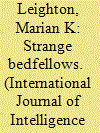

|
|
|
|
|
| Summary/Abstract |
A massive fortress-like structure dominating Normannenstrasse in East Berlin housed the headquarters of the East German Ministry for State Security (MfS), better known as the Stasi. It was a monument to the tasteless architecture of the Stalinist era. Passersby instinctively recoiled at the sight of the building. They could readily imagine the warren of cellblocks, interrogation rooms, and torture chambers deep inside its walls. Rumor had it that many of the cells were padded with burlap to muffle the screams of the torture victims, as well as to prevent prisoners from committing suicide by banging their heads to a bloody pulp against the concrete walls. The passersby also knew that an overzealous Stasi operative could emerge without warning to arrest and indict them for alleged crimes against the regime. Such “snoop and snatch” tactics were all part of a day's work for the MfS.
|
|
|
|
|
|
|
|
|
|
|
|
|
|
|
|
| 10 |
ID:
134897
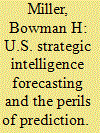

|
|
|
|
|
| Summary/Abstract |
Prediction, even of tomorrow's weather, remains a decidedly inexact science, but forecasting strategic geo-political or economic change is vastly more challenging. The Old Farmers’ Almanac has been in continuous publication in the United States since 1792, predicting long-term weather patterns and phases of the moon, among other things. But in 1942 the U.S. government sought to ban its publication after a German spy with a copy of the Almanac was apprehended. Suspicions centered on what the German might have found of intelligence value in this household volume, with special concern focused on “weather forecasts.” Confronted with a potential wartime ban on its publication, the Almanac relabeled that section “weather indications,” and the threatened ban was vacated. 2 The Almanac's “prediction” had nothing to do with warfare and everything to do with when to plant crops and gardens.
|
|
|
|
|
|
|
|
|
|
|
|
|
|
|
|
|
|
|
|
|